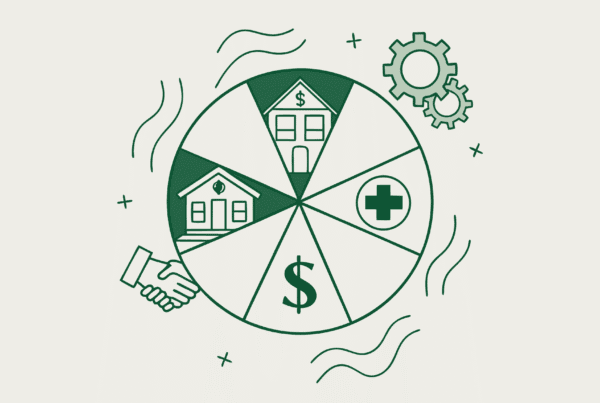The market for urgent care practices in Albuquerque is undergoing active consolidation. Recent acquisitions show strong buyer interest in our region, creating a significant opportunity for practice owners. However, capitalizing on this trend requires more than just a “For Sale” sign. A successful exit depends on strategic preparation and a deep understanding of your practice’s true value. This guide provides the initial insights you need to navigate this process.
The Albuquerque Urgent Care Market Landscape
The timing for selling your urgent care practice is influenced by powerful market forces, both nationally and here in New Mexico. Understanding this environment is the first step toward a successful transition.
National Growth Fuels Demand
The U.S. urgent care industry is expanding rapidly. The market was valued at over $34 billion in 2024 and is projected to grow 8.6% annually through 2030. This national boom means more capital is flowing into the sector. It also means buyers, from private equity to large health systems, are actively seeking acquisition opportunities. Your practice is part of a highly sought-after industry.
Local Competition and Opportunity
Here in Albuquerque, the market is mature and competitive. You operate alongside major players like Lovelace Health System, Presbyterian Healthcare Services, and UNM Health System. While this presents challenges, it also confirms the strategic importance of this area. Buyers want a foothold in a proven market. Your independent practice may represent a valuable and agile target for a larger organization looking to expand its footprint.
What Buyers Are Really Looking For
Beyond your top-line revenue, sophisticated buyers scrutinize specific aspects of your practice to determine its true value and future potential. Getting these details right before you go to market can significantly impact your final offer.
As you prepare for a sale, consider how your practice measures up in these four key areas:
- Operational Strength: Buyers look for efficiency. This includes your patient flow, billing and collection processes, and the experience of your clinical and administrative staff. A well-run practice is less risky and more attractive.
- Patient Base and Payer Mix: An established, loyal patient base is a major asset. You should be prepared to present clear data on your patient demographics, visit volume, and the diversity of your insurance payer mix.
- Competitive Advantage: In a crowded market like Albuquerque, what makes your practice unique? This could be a prime location, specialized services, extended hours, or a stellar community reputation.
- Growth Potential: Can a new owner expand services, add providers, or tap into a new patient population? Clearly outlining these opportunities helps a buyer see a future return on their investment.
Consolidation is Happening Now in New Mexico
The trend toward consolidation is not theoretical. It is actively reshaping the healthcare landscape in Albuquerque. Large, well-capitalized buyers are acquiring local and regional practices to expand their networks and service capabilities.
The most significant recent example is Ardent Health’s acquisition of NextCare clinics, with six New Mexico locations being integrated into the Lovelace Health System. This single transaction demonstrates that strategic buyers see immense value in established urgent care footprints in our state. For independent practice owners, this activity is a clear signal. It confirms that a strong buyers’ market exists and that your practice could be a prime target for a health system looking to grow.
| Buyer Type | Local Example | Strategic Goal |
|---|---|---|
| Regional Health Systems | Lovelace Health System | Expand outpatient network |
| National Operators | Ardent Health | Enter/deepen market presence |
| Private Equity Groups | (Various) | Build a regional platform |
How a Practice Sale Typically Unfolds
Selling your practice is not a single event. It is a structured process with distinct phases. Understanding this roadmap helps you prepare for what lies ahead and avoid common pitfalls. While every deal is unique, a successful transaction generally follows these stages:
- Preparation and Valuation. This is the foundational step. We work with owners to analyze financials, normalize earnings, and create a compelling narrative to establish a defensible valuation. Starting this 12-24 months before a sale is ideal.
- Confidential Marketing. Your practice is presentedwithout revealing its identityto a curated list of qualified financial and strategic buyers. This protects your staff and patient relationships while creating competitive tension among potential partners.
- Negotiation and Due Diligence. After initial offers are received, we negotiate terms. The selected buyer then performs a deep dive into your financials, operations, and legal standing. This is often the most intense phase, where expert preparation prevents surprises.
- Closing and Transition. Once legal documents are finalized, the sale is closed. A well-designed plan ensures a smooth transition for you, your staff, and your patients under the new ownership.
Determining Your Practice’s True Worth
One of the most common questions we hear is, “What is my practice worth?” While you may hear about simple revenue multiples, sophisticated buyers use a more detailed approach to arrive at a valuation.
Beyond Simple Revenue Multiples
You might see small urgent care centers listed for around 1x their annual revenue. This is a very rough guideline. It often fails to capture the true profitability and underlying health of the business. Private equity groups and health systems do not value practices this way. They look deeper.
The Power of Adjusted EBITDA
Buyers value your practice based on its cash flow, specifically its Adjusted EBITDA (Earnings Before Interest, Taxes, Depreciation, and Amortization). We calculate this by taking your net profit and adding back owner-specific expenses, like an above-market salary or personal car lease. This reveals the true earning power of the practice to a new owner. This Adjusted EBITDA figure, multiplied by a factor based on your practice’s size, growth, and stability, determines the real enterprise value. Optimizing this number is the foundation of a successful sale.
Planning for Life After the Sale
The day you close the deal is a beginning, not an end. A successful transaction includes a clear plan for what comes next for you, your team, and your financial future. Thinking about these elements during negotiations is critical to protecting your legacy and maximizing your outcome.
Here are a few things to consider:
- Your Transition Role. How involved do you want to be after the sale? Most buyers will want you to stay on for a transition period, typically 1 to 3 years. The terms of your employment contract, including your compensation and clinical responsibilities, are a key part of the negotiation.
- Your Staff’s Future. Your dedicated staff is one of your practice’s most valuable assets. A key part of the sale process is ensuring a smooth transition for them. We help structure deals that protect your team and align their incentives with the new ownership.
- The “Second Bite.” In many deals, a portion of your payout may come through an “earnout” (based on future performance) or “rolled equity” (retaining ownership in the new, larger company). This gives you a stake in the future success, offering the potential for a second, often larger, payday down the road.
Frequently Asked Questions
What is the current market situation for selling an Urgent Care practice in Albuquerque, NM?
The market for urgent care practices in Albuquerque is actively consolidating, with strong buyer interest from regional health systems, national operators, and private equity groups looking to expand their footprint. This creates a significant opportunity for practice owners to capitalize on the demand and sell their practices.
What factors do buyers consider when valuing an Urgent Care practice in Albuquerque?
Buyers look beyond top-line revenue and focus on areas such as operational strength (efficiency in patient flow, billing, and staff experience), patient base and payer mix (loyalty and diversity of insurance payers), competitive advantages (location, specialized services, reputation), and growth potential (ability to expand services or patient base). They often use adjusted EBITDA rather than simple revenue multiples to assess true value.
What are the typical phases involved in selling an Urgent Care practice?
The sale process generally includes four stages: 1) Preparation and Valuation, where financials are analyzed and the practice is prepared 12-24 months before sale; 2) Confidential Marketing to a curated list of qualified buyers; 3) Negotiation and Due Diligence involving deep examination of finances and legalities; 4) Closing and Transition with legal closing and a smooth handover plan.
How can I maximize the valuation of my Urgent Care practice before selling?
Optimizing your practice’s adjusted EBITDA by improving cash flow and reducing non-essential owner expenses is key. Demonstrating strong operational efficiency, a loyal patient base, clear competitive advantages, and growth opportunities will make your practice more attractive and increase the valuation multiplier that sophisticated buyers apply.
What should I consider about my personal and staff transition after selling my urgent care practice?
Plan your post-sale involvement, as most buyers want the owner to stay for 1 to 3 years to ensure a smooth transition. Negotiate terms including compensation and responsibilities. Protect your staff’s future by structuring the deal to maintain their incentives. Consider potential future payouts through earnouts or rolled equity to benefit from the practice’s continued success.



